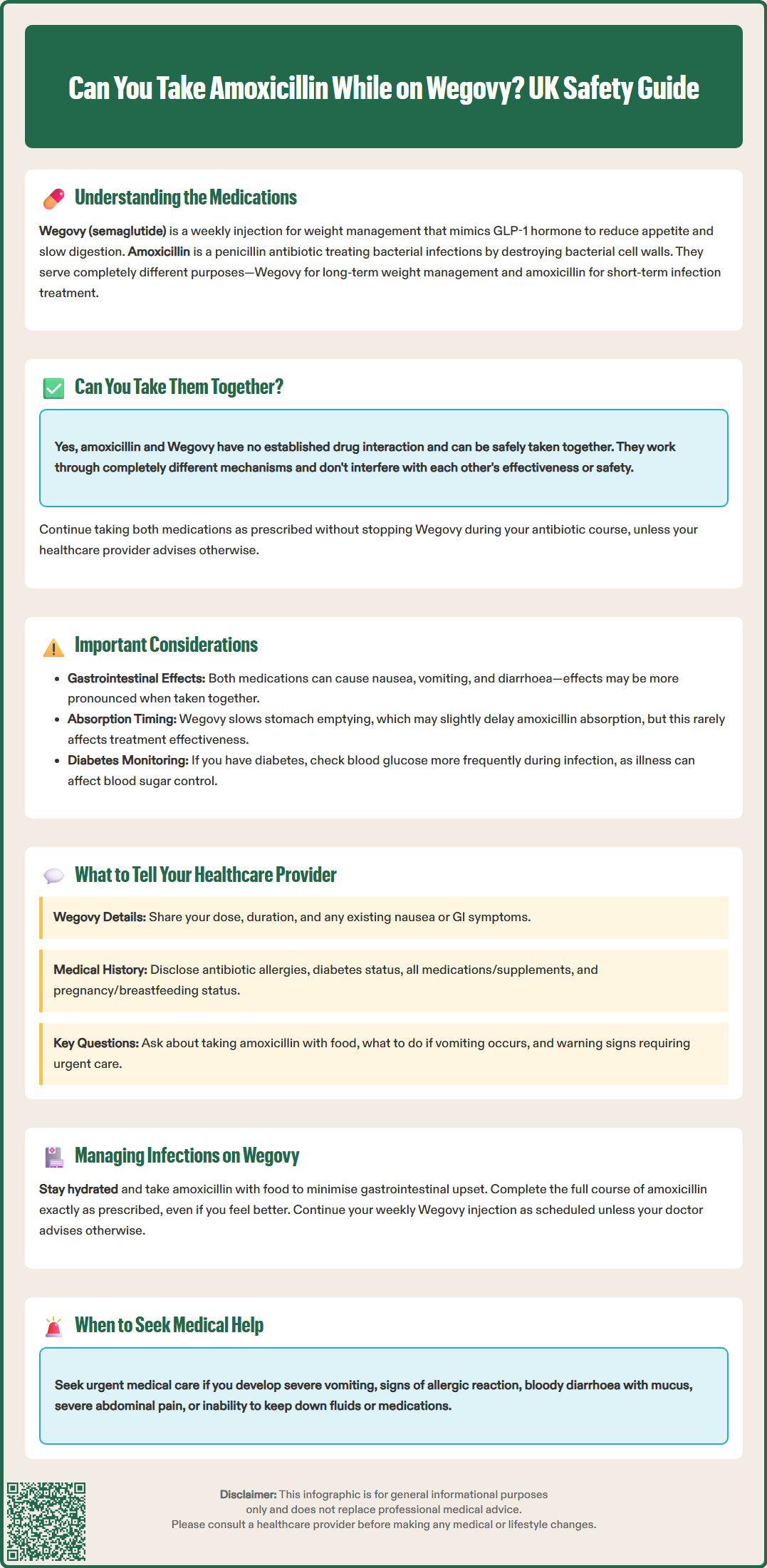
Can you take amoxicillin while on Wegovy? This is a common question for patients prescribed Wegovy (semaglutide) for weight management who develop bacterial infections requiring antibiotic treatment. Wegovy is a GLP-1 receptor agonist used for chronic weight management in adults with obesity or overweight with comorbidities, whilst amoxicillin is a widely prescribed penicillin antibiotic for treating bacterial infections. Understanding whether these medications can be safely combined is important for patients managing both long-term weight loss and acute infections. This article examines the safety profile, potential interactions, and practical considerations when taking amoxicillin alongside Wegovy, based on UK clinical guidance and regulatory information.
Quick Answer: Yes, amoxicillin can generally be taken safely whilst on Wegovy, as there is no established pharmacological interaction between these medications.
Wegovy (semaglutide) is a glucagon-like peptide-1 (GLP-1) receptor agonist licensed in the UK for chronic weight management in adults with obesity (BMI ≥30 kg/m²) or overweight (BMI ≥27 kg/m²) with at least one weight-related comorbidity. It is titrated over several weeks to a maximum dose of 2.4 mg once weekly. Wegovy works by mimicking the action of the naturally occurring hormone GLP-1, which regulates appetite and food intake. It slows gastric emptying, enhances satiety, and reduces hunger signals in the brain, leading to reduced caloric intake and sustained weight loss. The medication is administered via subcutaneous injection and is intended for use alongside a reduced-calorie diet and increased physical activity.
On the NHS, Wegovy is available according to NICE Technology Appraisal 875, which specifies eligibility criteria including BMI thresholds and participation in a specialist weight management service.
Amoxicillin is a broad-spectrum penicillin antibiotic widely prescribed in the UK for treating bacterial infections, including respiratory tract infections, urinary tract infections, dental abscesses, and skin infections. It functions by inhibiting bacterial cell wall synthesis, leading to bacterial cell death. Amoxicillin is generally well-tolerated and is commonly prescribed in primary care settings. It is available in various formulations, including capsules, oral suspension, and dispersible tablets.
Both medications serve entirely different therapeutic purposes—Wegovy addresses chronic weight management through metabolic pathways, whilst amoxicillin treats acute bacterial infections. Understanding how each medication works independently is essential before considering their concurrent use. Patients prescribed Wegovy for long-term weight management may occasionally require short-term antibiotic treatment for infections, making it important to understand whether these medications can be safely combined and what precautions, if any, should be observed.

Mounjaro® is the most innovative GLP-1 medication proven to dramatically curb appetite, hunger, and cravings to help professional men achieve substantial weight loss.
Start Here
Wegovy® is a weekly injectable GLP-1 medication with proven effectiveness in reducing appetite, hunger, and cravings to help busy professionals lose significant weight.
Start HereThere is no established pharmacological interaction between amoxicillin and Wegovy (semaglutide), and these medications can generally be taken together safely. Neither the Medicines and Healthcare products Regulatory Agency (MHRA) nor the European Medicines Agency (EMA) has identified any direct drug-drug interaction between these two agents. The mechanisms of action are entirely distinct: amoxicillin targets bacterial cell walls, whilst semaglutide acts on GLP-1 receptors to regulate glucose metabolism and appetite.
From a pharmacokinetic perspective, amoxicillin is primarily eliminated unchanged via renal excretion and does not undergo significant hepatic metabolism. Wegovy is metabolised through proteolytic degradation, similar to endogenous proteins, without involvement of cytochrome P450 enzymes. This means there is no competition for metabolic pathways that might alter the efficacy or safety profile of either medication.
However, one practical consideration relates to Wegovy's effect on gastric emptying. According to the Wegovy SmPC, semaglutide delays gastric emptying, which could theoretically affect the absorption rate of oral medications, including amoxicillin. In clinical practice, this effect is generally modest and does not significantly compromise antibiotic efficacy. The overall bioavailability of amoxicillin remains adequate for therapeutic effect, even with delayed gastric transit.
Patients should continue taking both medications as prescribed unless specifically advised otherwise by their healthcare provider. If you have been prescribed amoxicillin whilst taking Wegovy, there is generally no need to discontinue your weight management medication during the antibiotic course. However, if you experience severe vomiting, dehydration, or acute abdominal pain, seek medical advice promptly as your next Wegovy dose may need to be deferred.

Whilst direct pharmacological interactions between amoxicillin and Wegovy are not documented, several clinical considerations warrant attention when taking these medications concurrently.
Gastrointestinal side effects represent the most relevant consideration. Both medications can independently cause gastrointestinal disturbances. According to clinical trials and the Wegovy SmPC, semaglutide commonly causes nausea (occurring in up to 44% of patients), vomiting (approximately 25%), diarrhoea (30%), constipation, and abdominal discomfort, particularly during dose escalation. Amoxicillin can also cause gastrointestinal upset, including diarrhoea, nausea, and abdominal pain in some patients. When taken together, there may be an additive effect on gastrointestinal symptoms, potentially making nausea or diarrhoea more pronounced.
Patients experiencing significant gastrointestinal symptoms should ensure adequate hydration and may benefit from taking amoxicillin with food to minimise stomach upset. If vomiting occurs after taking amoxicillin, do not take another dose unless specifically advised by your healthcare provider or pharmacist. Instead, contact your GP for guidance.
Delayed gastric emptying caused by Wegovy could theoretically affect the timing of amoxicillin absorption, though this rarely impacts clinical efficacy. For most infections, amoxicillin's therapeutic window is sufficiently broad that minor delays in absorption do not compromise treatment outcomes.
Blood glucose considerations are relevant for patients with diabetes taking Wegovy. Whilst amoxicillin does not directly affect blood glucose, acute infections themselves can cause glycaemic variability. Patients with diabetes should monitor blood glucose more frequently during infection and antibiotic treatment, as illness and stress can affect glucose control independently of medication interactions. Those taking insulin or sulfonylureas should be particularly vigilant for hypoglycaemia if their food intake is reduced due to illness or GI symptoms.
Patients should be alert for signs of antibiotic-associated diarrhoea, particularly diarrhoea containing blood or mucus, or accompanied by severe abdominal cramping, which could indicate Clostridioides difficile infection requiring urgent medical attention.
Open communication with your healthcare provider is essential when taking multiple medications. When prescribed amoxicillin whilst on Wegovy, or when starting Wegovy whilst taking antibiotics, ensure your GP or prescriber is aware of your complete medication list.
Key information to share includes:
Current Wegovy dose and duration of treatment – Mention how long you have been taking Wegovy and your current weekly dose, as side effects vary during dose escalation phases.
Any gastrointestinal symptoms – If you are already experiencing nausea, vomiting, or diarrhoea from Wegovy, inform your prescriber, as adding amoxicillin may temporarily worsen these symptoms.
History of antibiotic allergies – Always disclose any previous allergic reactions to penicillin antibiotics or other medications, as this is crucial for safe prescribing.
Diabetes status – If you have type 2 diabetes, inform your healthcare provider, as infection management may require closer glucose monitoring.
Other medications and supplements – Provide a complete list of all prescription medications, over-the-counter products, and supplements you are taking.
Pregnancy, breastfeeding, or plans to conceive – Wegovy is contraindicated during pregnancy and breastfeeding, so this information is essential for your healthcare provider.
Questions to ask your healthcare provider:
Should I take amoxicillin with or without food to minimise side effects?
What should I do if I experience vomiting after taking amoxicillin?
Are there any warning signs that would require urgent medical attention?
Should I adjust my Wegovy injection timing during the antibiotic course?
Your pharmacist is also an excellent resource for medication advice and can provide practical guidance on timing doses and managing side effects. Do not stop or adjust Wegovy without medical advice, even if you are prescribed antibiotics, as maintaining consistency with weight management medication is important for therapeutic outcomes. However, seek urgent medical advice if you experience severe or persistent GI symptoms or acute abdominal pain.
Effective infection management whilst continuing Wegovy requires attention to both antibiotic efficacy and weight management medication adherence. Most bacterial infections requiring amoxicillin are short-term conditions, and there is generally no need to interrupt Wegovy treatment during this period.
Practical strategies for managing concurrent treatment include:
Maintain hydration – Both medications can cause gastrointestinal upset, making adequate fluid intake essential. Drink plenty of fluids, tailored to your individual circumstances and any existing health conditions such as kidney disease or heart failure.
Take amoxicillin with food – This can help reduce stomach upset. However, amoxicillin absorption is not significantly affected by food, so this adjustment is primarily for comfort.
Continue Wegovy as scheduled – Administer your weekly Wegovy injection on your regular day unless your healthcare provider advises otherwise. Consistency is important for maintaining therapeutic blood levels.
Monitor for side effects – Be alert for increased gastrointestinal symptoms. Mild nausea or loose stools are manageable, but persistent vomiting or severe diarrhoea requires medical review.
Take antibiotics exactly as prescribed – Take amoxicillin at the prescribed intervals and for the duration specified by your healthcare provider. Do not stop early unless advised by your clinician.
When to seek medical advice:
Severe or persistent vomiting preventing medication or fluid intake
Signs of allergic reaction (rash, facial swelling, difficulty breathing)
Severe diarrhoea lasting more than 48 hours
Diarrhoea containing blood or mucus, or accompanied by severe abdominal cramping
Worsening infection symptoms despite antibiotic treatment
Severe or acute abdominal pain (which could indicate pancreatitis or gallbladder disease)
If you cannot keep fluids or medicines down or are severely dehydrated, seek medical advice promptly. Your next Wegovy dose may need to be deferred until you have recovered.
For patients with diabetes, monitor blood glucose levels more frequently during infection, as illness can affect glycaemic control. Contact your diabetes care team if blood glucose remains consistently elevated or if you are unsure about medication adjustments. Most patients tolerate amoxicillin and Wegovy together without significant issues, and short-term antibiotic treatment should not derail long-term weight management goals.
Yes, amoxicillin and Wegovy can generally be taken together safely, as there is no established pharmacological interaction between these medications. However, both can cause gastrointestinal side effects, so monitor for increased nausea or diarrhoea and maintain adequate hydration.
Wegovy delays gastric emptying, which may slightly slow amoxicillin absorption, but this rarely affects clinical efficacy. The overall bioavailability of amoxicillin remains adequate for treating bacterial infections even with delayed gastric transit.
No, you should generally continue taking Wegovy as scheduled during a short course of amoxicillin unless your healthcare provider advises otherwise. Consistency with weight management medication is important for therapeutic outcomes.
All medical content on this blog is created based on reputable, evidence-based sources and reviewed regularly for accuracy and relevance. While we strive to keep content up to date with the latest research and clinical guidelines, it is intended for general informational purposes only.
DisclaimerThis content is not a substitute for professional medical advice, diagnosis, or treatment. Always consult a qualified healthcare professional with any medical questions or concerns. Use of the information is at your own risk, and we are not responsible for any consequences resulting from its use.